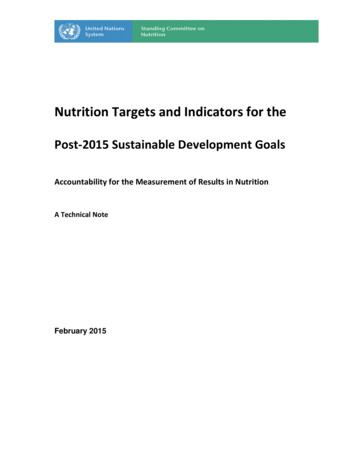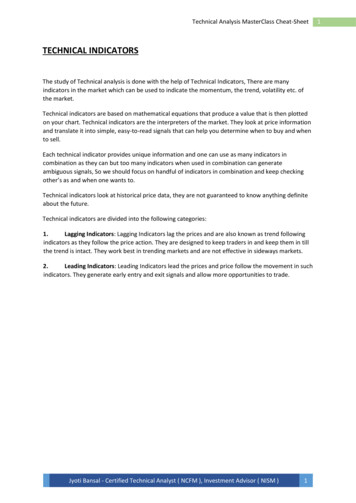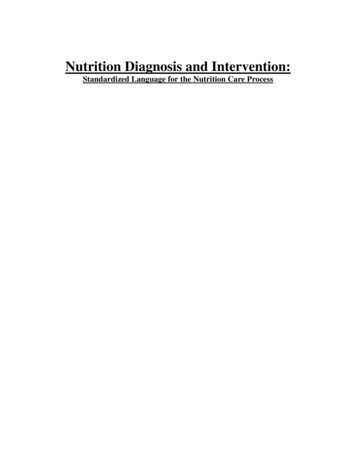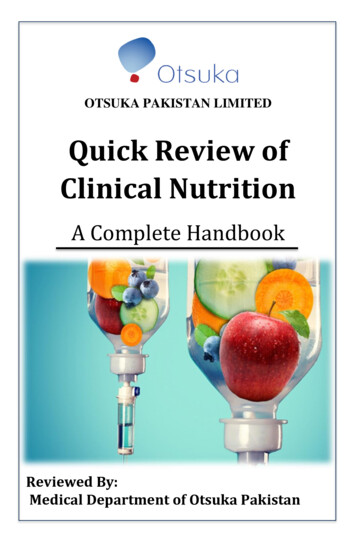
Transcription
Nutrition Targets and Indicators for thePost-2015 Sustainable Development GoalsAccountability for the Measurement of Results in NutritionA Technical NoteFebruary 2015
Nutrition targets and indicators for the SDGsACKNOWLEDGEMENTSThis paper was written by Eline Korenromp PhD, Futures Institute and Marzella Wüstefeld PhD,UNSCN Secretariat.Inputs were generously provided by colleagues from the Food and Agriculture Organization, WorldFood Programme and World Health Organization. In addition, contributions are acknowledged fromMonika Barbara Bloessner, Jessica Fanzo, Patrizia Fracassi, Helen Connolly, Jennifer Coates,Lawrence Haddad, Barrie Margetts, Rebecca Olson, Fred Arnold, Patrick Webb, and JaniceMeerman. The UNSCN Secretariat wishes to thank all for their support and advice.The funding by the Government of the Federal Republic of Germany, through BMEL, is gratefullyacknowledged.This report is also available at the UNSCN website at www.unscn.org.2
Nutrition targets and indicators for the SDGsTable of Contents1. INTRODUCTION1.1 Nutrition is integral to Sustainable Development1.2 The MDG agenda is incomplete1.3 The nutrition landscape has changed1.4 Nutrition and the Sustainable Development Goals2. TARGETS AND INDICATORS2.1 Priority nutrition targets and indicators for the SDGs2.2 Other optional indicators of significant importance2.3 Intervention coverage indicators for country-level monitoring2.4 Key Messages3. ACCOUNTABILITY FOR THE MEASUREMENT OF RESULTS IN NUTRITION3.1 Measurement and Information Systems3.2 Accountability for Results3.3 Key MessagesANNEXAnnex 1: Rational for inclusion of all six WHA targets in the SDGsAnnex 2: Data collection systems for nutrition measurementAnnex 3: Measurement systems and current data tracking status for global nutrition targetsAnnex 4: Coverage indicators of nutrition-specific interventionsAnnex 5: List of AbbreviationsAnnex 6: References.3
Nutrition targets and indicators for the SDGsI) INTRODUCTION1.1 Nutrition is integral to sustainable developmentNutrition is to be understood as both an input to and an outcome of sustainable development.Malnutrition -which includes several forms of undernutrition as well as overweight and obesityderives not just from a lack of food, but from a host of interacting processes linking health, care,education, sanitation and hygiene, access to resources, women’s empowerment and more. The choicesthat individuals make regarding what foods to produce and market, what diets their families consume,and the care and nurture of nutritionally vulnerable people (particularly mothers and infants), all havea direct bearing on nutrition outcomes.At the individual level good nutrition is necessary for achieving optimal physical and mentaldevelopment during childhood, and has been linked to improved academic performance and higherwage rates during adolescence and adulthood. At population level, these benefits support increasedeconomic growth and welfare gains, two sustainable development requisites.Conversely, poor nutrition impairs labour productivity, which in turn impedes national economicgrowth. Without appropriate investments and action, poor nutrition contributes to the global burden ofdisease, impairs quality of life, and acts as a brake on economic growth worldwide. In this sense,malnutrition poses a pernicious, often invisible, impediment to achieving all the Post-2015Sustainable Development Goal (SDG) targets.As such, the nutrition community, and its natural allies in the food systems, agriculture, WASH,gender, social protection and health communities, are advocating for action oriented, measurabletargets for improved nutrition within the SDG framework [1].This technical note encourages dialogue on targets and related indicators to monitor, report on andaccount for progress towards improved nutrition across the post-2015 agenda. The note is organizedas follows: The rest of this introduction provides background on the Millennium Development Goals,changes in the nutrition landscape over the last decade, and the suggested SDGs. The followingsection covers proposed global nutrition targets and indicators; embedding nutrition indicators in theSDGs; and intervention coverage indicators for country-level monitoring. The final section addressesthe issue of accountability, first with regards to ensuring that data collection and national informationsystems can accurately measure progress in nutrition by providing high quality, timely anddisaggregated data; and second with a discussion of national cost estimates and tracking of resourcesfor nutrition.1.2 The MDG agenda is incompleteIn the year 2000, world leaders adopted the Millennium Declaration and agreed on a set of eightMillennium Development Goals” (MDGs) to be met by September 2015. MDG1 brought attention tothe need to improve food and nutrition security (Goal 1C: to halve the proportion of people who sufferfrom hunger) [2], with its two indicators for monitoring progress: indicator 1.8 Prevalence ofunderweight children under-five years of age; and indicator 1.9 Proportion of population belowminimum level of dietary energy consumption. A more colloquial and commonly used term for thislatter indicator is “undernourishment” (SOFI 2013).Overall, however, the MDG nutrition focus was minimal. Moreover, without having specified how toachieve the nutrition - and other - targets, country ownership of the goals was hamstrung. To date,while unprecedented progress has been made in poverty eradication and human development, many ofthe targets, including MDG-1C, are far from being achieved.4
Nutrition targets and indicators for the SDGsLessons learnt from the MDG framework specific to nutrition include the realization that the focus onundernutrition was too narrow, and that synergies between nutrition and other sectors wereunderexploited. For example, many national nutrition strategies in the 2000s focused almostexclusively on treatment of acute malnutrition (wasting). Anchored in ministries of health, thesestrategies often did little to encourage food based approaches to reducing malnutrition. In manycountries, the disconnect was further exacerbated by food security policies whose primary objectivewas increased production of staple grain [3]. Today, in contrast, a huge body of knowledge exists on“the multi-sectoral approach”, including holding the food and agriculture sectors accountable fornutrition [4].It is important to note that the “uni-sectoral” approach which fragmented nutrition strategy in the2000s not only limited progress toward the achievement of MDG1 targets, but probably also slowedprogress in achieving other related targets such as poverty reduction, education, child mortality andmaternal health [5].1.3 The nutrition landscape has changedSince 2000, the nutrition situation has become more complex, with many countries experiencingmultiple burdens of undernutrition, overweight and micronutrient malnutrition. In some contexts, allthree conditions may occur simultaneously at household and even individual level [6].This current scenario is attributed to dietary changes associated with rapid urbanization, moresedentary lifestyles, and increased consumption of processed foods, often referred to as “foods ofminimal nutrition value”. These three global trends have contributed to rising trends in overweight,obesity and diet-related noncommunicable diseases worldwide.At the same time, climate change and associated natural severe weather events are resulting infrequent food crises, with subsequent increased incidence of food insecurity and food price instability.These are sometimes exacerbated by trade globalization and increased competition for ecosystemservices. Socio-economic inequities in malnutrition persist, and nutrition improvements have notalways been equitable [3].Since 2010, the global Scaling Up Nutrition (SUN) Movement has been instrumental in stimulatingand sustaining political commitment to addressing this state of affairs [7]. SUN is country-led, to date,there are 54 countries participating, and is unique in bringing different groups of people together –governments, civil society, the United Nations, donors, businesses and scientists – in a collectiveeffort to improve nutrition.The Second International Conference on Nutrition (ICN2) convened in November 2014 reaffirmedcountries’ commitment to reducing malnutrition. The ICN2 framed the post-2015 developmentagenda as an unprecedented opportunity to steer action and increase accountability in addressing boththe direct and underlying causes of malnutrition [8].Finally, empirical evidence on “what works” to improve nutrition has increased significantly. The2008 Lancet Series on maternal and child undernutrition created consensus on a suite of effective“direct” nutrition-specific actions to address the most immediate, proximal causes of malnutrition [9].Program- and policy wise, the concept of direct nutrition actions has contributed to an increasedemphasis on “the first 1000 days” of life (from conception to 24 months) as a critical window ofopportunity to sustainably establish good nutrition and growth. Evidence on this subject has alsostrengthened the economic case for nutrition - the returns on investment on these types ofinterventions are very high - and provided a platform for SUN and related initiatives to advocate fornutrition as integral to sustainable development [10].5
Nutrition targets and indicators for the SDGsA second Lancet series, published in 2013, provides additional evidence reinforcing the importanceof scaling up direct nutrition actions and also provides new information on “nutrition-sensitive”interventions [11]. Nutrition-sensitive interventions span a variety of sectors and address underlyingas well as basic determinants of nutritional status. They are an essential component of themultisectoral approach described above, involving agriculture, food systems, social protection,education, water and sanitation, and a number of other sectors in addition to health. In line with thegrowing evidence base and heightened advocacy for nutrition sensitivity across a range of sectors(e.g. reinforced through the ICN2 and the SUN movement), more and more national nutrition plansare taking a multi-sectoral approach [12].1.4 Nutrition and the Sustainable Development GoalsThe UN Open Working Group (OWG) recommended 17 SDGs and 169 targets to be achieved by2030, which were acknowledged and welcomed by the UN General Assembly in September 2014[13,14]. SDG 2 - ‘End hunger, achieve food security and improved nutrition, and promote sustainableagriculture’- contains one provision on nutrition in the context of food security and sustainableagriculture. This is an achievement. However, the risk of this phrasing is that the concept of“improved nutrition” becomes reduced to hunger reduction and food security with a focus on theaccess to enough food.A more correct, holistic vision of nutrition requires the recognition that access to enough food isinsufficient, and that rather, good nutrition is a product of accessing the right nutrients at the righttime. It also requires the recognition that health care and social protection may play a crucial role,especially for mothers during pregnancy and lactation, and for young children during the first twoyears of life.Among the 169 proposed targets, one target is directly related to malnutrition. The target 2.2: “by2030 end all forms of malnutrition, including achieving by 2025 the internationally agreed targets onstunting and wasting in children under five years of age, and address the nutritional needs ofadolescent girls, pregnant and lactating women, and older persons”.The first part of target 2.2 makes explicit reference to two of the World Health Assembly (WHA)adopted targets (on stunting and wasting in children less than five years of age) for the improvementof maternal, infant and young child nutrition (WHA, A65/11, 2012). Conversely, the second part isexpressed as a political statement with space to add more specific defined nutrition targets left open.With SDG 2 as starting points, this paper addresses the following critical issues: At a minimum, embed all six WHA targets addressing all forms of malnutrition within theSDG framework.It is incomplete and insufficient to consider food access solely in terms of total dietary energysupply. Diet quality merits particular attention, especially in light of the multiple burdens ofmalnutrition and their interconnectedness with today’s food systems.Tracking of overall government spending on nutrition is essential for results in nutrition.Overweight and obesity in adults related to the rising trends in non-communicable diseasesshould be addressed by the future SDG agenda.To underscore the importance of complementary national indicators, and as none of thecurrent 169 targets addresses the ‘how’ of improving nutrition, countries (beyond the 54 SUNcountries where such processes are already underway) should include targets for coverage ofkey nutrition actions in their SDG frameworks.Shortcomings in the nutrition data collection “toolkit” and recommendations for improvingdata quality and standardization at scale.6
Nutrition targets and indicators for the SDGsII)TARGETS AND INDICATORS FOR NUTRITION IN THESDGs2.1 Priority nutrition targets and indicatorsThe six global nutrition targets adopted at the WHA 2012Selection criteria for global nutrition targets and related indicators [15-17] include scientificrobustness, a strong track record of extensive measurement experience, and use by countries inmonitoring of national plans and programs. The six global targets for maternal and child nutritionendorsed by the 65th World Health Assembly (WHA) fulfil these criteria [18-20]. All six are based oncredible evidence of human benefit and it is strongly recommended that the entire suite be included astargets with relevant indicators as part of the SDGs. The WHA targets are as follows:1.2.3.4.5.6.Reduce the number of children under-five who are stunted by 40%;Reduce and maintain childhood wasting to less than 5%;No increase in childhood overweight (children under 5 years of age);Reduce anaemia in women of reproductive age (pregnant and non-pregnant) by 50%;Increase the rate of exclusive breastfeeding in the first six months to at least 50%;Reduce low birth weight by 30%.The SDGs will likely be set until 2030, whereas the WHA targets are to be achieved by 2025.Corresponding SDG targets may be set for the 6 WHA targets for the year 2030 at more ambitiouslevels, since documented experiences in several countries suggest that with political will, the rightmix of policies and adequate resources, it is feasible to make dramatic improvements in maternal andchild nutrition [6]. WHO is currently working on these 2030 targets for the 6 WHA indicators. Furtherdetails on the rationale for each WHA target are provided in Annex 1.In addition, indicators that go beyond the WHA targets need to be carefully considered in the post2015 framework. Priority indicators include those related to diet quality and diversity, as well asindicators which aim to assess political commitment that is essential to scaling up direct nutritionactions and to investment in nutrition sensitive programming. Proposals to date include metrics whichcapture overall national government spending on nutrition.Measure of dietary qualityAs Jeffrey Sachs puts it in his address at the ICN2 Roundtable on Nutrition in the post-2015development agenda [21], the SDG 2 is a challenging goal because it looks at agriculture, nutrition,and food security in an integrated manner. Consequently, its assessment requires addressing the linksbetween adequate nutrition, real food needs, food production and sustainable agriculture. Measures ofdietary quality are a step into the right direction as they push past the “quantity” concept of totaldietary energy supply to focus on the quality of foods which are produced and available in a givenfood environment.The rationale for the inclusion of the metrics on dietary diversity is found in SDG 2 itself: Endhunger, achieve food security and improved nutrition, and promote sustainable agriculture. Aspreviously discussed, this SDG requires connecting food systems, including agricultural production,with diversified and healthy diets in a coherent way. As an indicator of dietary quality andmicronutrient access, individual diet diversity scores can help do just this. In contrast, conducting“business as usual” and including only the MDG indicator on undernourishment (percentage ofpopulation below minimum level of dietary energy consumption) is insufficient, as undernourishment7
Nutrition targets and indicators for the SDGsat best provides only a population level estimate of total energy supply, i.e. “quantity”, with noinformation provided on “quality”.Measures of dietary quality are also critical to the six WHAtargets. Beyond food quantities, the importance of nutritionalquality and diversity of foods consumed is increasinglyrecognized as essential for a healthy diet, as malnutrition haspersisted in many populations despite sufficient foodavailability and access.Dietary diversity is a robust predictor of diet quality andmicronutrient adequacy in both women and young children[22-24]. Recent studies suggest that the importance of dietarydiversity as a determinant of stunting has increased [25].Existing measures capture diet quality for women and children6-23 months. Of note, especially with regard to the WHAtargets, no dietary diversity metric exists for children 24mwhich leaves out a considerable time window when a reductionin wasting in children up to 59 months of age is envisaged.This is one of the gaps that deserve further attention. WHAtargets are for children up to 5 years.The proposed priority indicator of adequate diet diversity forthe SDG framework is the following one: Minimum Dietary Diversity for women (MDD-W): definedas the proportion of women, 15-49 years of age, whoconsume at least 5 out of 10 defined food groups [26]. Thisis a valid indicator of women’s diet quality with specificfocus on micronutrient adequacy. Maternal micronutrientdeficiencies during lactation can directly impact childgrowth and development, but the potential consequences ofmaternal micronutrient deficiencies are especially severeduring pregnancy, when there is the greatest opportunityfor nutrient deficiencies to cause long term, irreversibledevelopment consequences to the fetus.Priority list ofrecommended nutritiontargets and indicators1. Prevalence of stunting (lowheight-for-age) in children under5 years of age2. Prevalence of wasting (lowweight-for-height) in childrenunder 5 years of age3. Percentage of infants less than6 months of age who areexclusively breast fed4. Percentage of women ofreproductive age (15-49 years ofage) with anaemia5. Prevalence of overweight (highweight-for-height) in childrenunder 5 years of age6. Percentage of infants bornwith low birth weight ( 2,500grams)7. Adequate Dietary DiversityThe percentage of women, 15-49years of age, who consume atleast 5 out of 10 defined foodgroupsThis indicators is currently endorsed by the internationalcommunity for monitoring of progress in globalframeworks [26]. As such, it is proposed to include MDDW as an indicator for diet quality in the SDG framework.8. Means of ImplementationIn addition to providing an essential measure of diet qualityPercentage of national budgetamong one of the most important demographics forallocated to nutritionnutrition – women – inclusion of the MDD-W in the SDGswill also facilitate cross-country validation. Whilevalidated as an indicator of individual-level diet quality andof micronutrient quality, this indicator has not yet beentested for cross-country comparability [6], or for adolescent girls.Measure of political commitmentThe evidence-based solutions to end malnutrition are known. Therefore an indicator is recommendedto measure the means of implementation made available for nutrition-specific and nutrition-sensitiveactions according to national plans. This reinforces that nutrition is foundational for sustainabledevelopment. As the Global Nutrition Report 2014 states, an indicator is the cornerstone ofaccountability. To ensure accountability, it is vital that expenditures on nutrition be disaggregated and8
Nutrition targets and indicators for the SDGsseparately tracked. Similarly, it is critical that Official Development Assistance (ODA) measuresdisaggregate funding for nutrition, given the multi-sectoral nature of nutrition [27]. Countriesparticipating in the SUN Movement are working on a tracking system of government spending innutrition, and an important milestone was the Nairobi Workshop on Costing and Financial Tracking inNovember 2013. The proposed indicator for the SDG Framework is: National budget allocation to nutrition: defined as percentage of overall national budget allocatedto nutrition. This indicator measures the overall national government’s spending on directnutrition actions as well as on nutrition-sensitive actions in related sectors.Embedding priority nutrition indicators in the SDGsSDG 2, target 2.2 - by 2030 end all forms of malnutrition, including achieving by 2025 theinternationally agreed targets on stunting and wasting in children under five years of age, andaddress the nutritional needs of adolescent girls, pregnant and lactating women, and older persons is the most obvious “home” for indicators addressing nutrition.In order to include the priority nutrition indicators discussed above, it is recommended that target 2.2be expanded 1) to include the full set of all 6 global targets adopted by the WHA 2012, treating thiscomprehensive set as one indicator of maternal and child nutrition, and 2) to include a measure ofmeans of implementation especially the percentage of national budget allocated to nutrition.It is furthermore proposed to expand SDG2, target 2.1 – by 2030 end hunger and ensure access by allpeople, in particular the poor and people in vulnerable situations including infants, to safe, nutritiousand sufficient food all year round - to ensure that diet diversity of women be recognized as animportant metric.In addition to SDG2, the beforehand outlined priority nutrition targets and indicators also have a placein other SDGs. Particular focus should be put on SDG3.SDG 3 on ‘ensuring healthy lives and promote well-being for all at all ages’:Within target 3.1 defined as ‘by 2030 reduce the global maternal mortality ratio to less than 70 per100,000 live births, the following WHA nutrition targets could be embedded:o Percentage of women of reproductive age (15-49) with anaemiaWithin target 3.2 defined as ‘by 2030 end preventable deaths of newborns and children under 5 yearsof age’, the following WHA nutrition targets could be embedded:o Percentage of children less than six months old who are fed exclusively breast milko Percentage of infants born low birth weight (less than 2,500 grams)Within target 3.4 defined as ‘by 2030 reduce by one third premature mortality from noncommunicable diseases through prevention and treatment’, the relevant nutrition targets would be:o Prevalence of overweight (high weight-for-height) in children under 5 years of ageThere is broad consensus around the priority indicators as summarized below that efficiently andcomprehensively measure progress in the most critical areas of action to improve nutrition and otherdevelopment outcomes.9
Nutrition targets and indicators for the SDGsAreaGlobal Nutrition Targetsendorsed by MemberStates at the 65th WorldHealth Assembly (WHA2012)Dietary DiversityPolicyPriority IndicatorPrevalence of stunting (low height-for-age) inchildren under 5 years of agePrevalence of wasting (low weight-for-height) inchildren under 5 years of agePercentage of infants less than 6 months of age whoare exclusively breast fedPercentage of women of reproductive age (15-49years of age) with anaemiaPrevalence of overweight (high weight-for-height)in children under 5 years of agePercentage of infants born with low birth weight ( 2,500 grams)The percentage of women, 15-49 years of age, whoconsume at least 5 out of 10 defined food groupsPercentage of national budget allocated to nutritionSDGs and TargetsGoal 2, Target 2.2Goal 2, Target 2.2Goal 2, Target 2.2 and Target 2.1and Goal 3, Target 3.2Goal 2, Target 2.2 andGoal 3, Target 3.1Goal 2, Target 2.2 andGoal 3, Target 3.4Goal 2, Target 2.2 andGoal 3, Target 3.2Goal 2, Target 2.1Goal 2, Target 2.2a2.2 Other optional indicators of significant importanceBesides the eight priority indicators, other optional indicators relate to nutrition outcomes among whatare often neglected and vulnerable groups, namely: Obese adults, the elderly, displaced peoples, andadolescents (especially girls) and who are important to be considered.As with other forms of malnutrition, the costs of obesity and overweight are high, not only in terms ofdisability and a diminished quality of life, but also in terms of lost productivity and burden onhealthcare systems. Reversing rising trends in overweight and obesity and reducing the burden of dietrelated non-communicable diseases in all age groups is thus an imperative for sustainabledevelopment. As such, the following indicator is recommended for the global monitoring frameworkof the SDGs: Overweight and obesity in adults (disaggregated by sex): Age-standardized prevalence ofoverweight and obesity in persons aged 18 years (defined as body mass index 25 kg/m² foroverweight and body mass index 30 kg/m² for obesity) [28]. This is one of the indicators in theGlobal action plan for the prevention and control of non-communicable diseases 2013-2020 [29]The number of older persons – defined by 60 years of age or older – is growing globally and theworldwide trends are likely to continue to rise. By 2025, the worldwide number of elderly persons isexpected to reach more than 1.2 billion, with nearly 840 million in low-income countries. Nutrition isan important determinant of health and mortality in older persons. They are at a higher risk ofmalnutrition due to physical causes, such as body changes, impaired vision, loss of taste as well asillness and disability, which can result in an increased risk of malnutrition. Therefore, it is importantto monitor nutritional status of this vulnerable population to help reduce the incidence of malnutritionand improve health [30,31]. Nutritional status of older persons: Ideally the proposed indicators should address older personsas formulated in the SDG2 target 2.2. However, there are no indicators, other than deficiency inVitamin B12 and low nutritional status measured as low BMI, to assess nutrition of older personsthat could be recommended as global targets. Given the growing significance of older persons inmany parts of the world, there is an urgent need for adequate research to address this informationgap.Undernutrition and mortality in humanitarian situations is tragically high; global progress towardsSDG health targets will be significantly constrained unless mortality and undernutrition in refugee andother emergency-affected populations is explicitly reduced. The September 2014 meeting of the SUN10
Nutrition targets and indicators for the SDGsLead Group stressed the importance of strengthening capacities and resilience in countries dealingwith recurring humanitarian crises. To date, however, there is no reference in the SDGs to populationsin emergency situations. As such the gap in nutrition targets and indicators applicable to people inemergency situations should be addressed: Nutritional status of displaced peoples and those in humanitarian settings.Optional measure on dietary diversity: Minimum Dietary Diversity for children 6-23 months: defined as the proportion of children 623 months of age who receive foods from four or more food groups, indicating adequatediversity in the composition of complementary foods for infants and young children duringthe second half of the 1000-day window of opportunity. During this period continuedbreastfeeding should be complemented with semi-solid and solid foods. Minimum dietarydiversity predicts lower rates of stunting and wasting [6,25], and is a WHO-recommendedprogress indicator for child nutrition and growth [32].Optional measure on policy: Number of health professionals who are trained in nutrition per 100,000 population: Thisindicator measures density of health professionals trained in nutrition in a given country, relativeto the rest of the population. It reflects the capacity of a country to design and implement anutrition policy and programmes effectively. This indicator is adapted from the WHO NutritionLandscape Information System (NLIS) [33] and the WHO’s World Health Statistics (WHS)database [34].Other optional nutrition measures include: Overweight in school- age children and adolescents (disaggregated by sex): Percentage ofoverweight ( 1SD body mass index for age and sex) in school-age children and adolescents(5-18 years). Underweight in women of reproductive age: Percentage of women of reproductive age whoare underweight (with low BMI of 18.5kg/m2). Underweight in school aged and adolescent girls Underweight in older people Household Food Consumption Score (FCS): A measure of household food security used byWFP’s food security Analyses, FCS is a composite index based on household level dietarydiversity (number of food groups consumed by a household over a 7-day reference period),food frequency (number of times, usually in days, a particular food group is consumed), andthe relative nutritional value of different food groups. Food consumption can be a function offood availability and/or food access; as a result, the FCS can potentially reflect two of thethree dimensions of food security [35]. The following complementary indicators that address the nutrition status
time. It also requires the recognition that health care and social protection may play a crucial role, especially for mothers during pregnancy and lactation, and for young children during the first two years of life. Among the 169 proposed targets, one target is directly related to malnutrition. The target 2.2: "by











